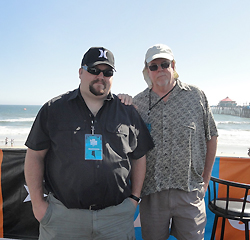At this year’s U.S. Open of Surfing, a nine-day broadcast event in which the top surfers in the world compete for a $100,000 top prize, digital Sennheiser MKH Series microphones were on hand to capture every sonic detail of the excitement – which also included a BMX riding and skating competition.
The annual U.S. Open of Surfing is attended by over 500,000 people and held on a beach that stretches over 300 yards. For this year’s event, held in Huntington Beach, CA, Hollywood-based Coffey Sound deployed Sennheiser’s latest MKH shotgun microphones: the MKH 8060 and MKH 8070, equipped with MZD 8000 digital output modules.
The digital microphones not only provided improved clarity and detail of the audio, but also provided an important element of weather resistance required to take on a cruel outdoor environment fraught with wind, moisture and salty air.
The nine-day event focused on three primary broadcast locations: the surf venue, the BMX riding venue and the skateboarding bowl. Gary Vahling, who is also the rental manager at Coffey Sound, served as the A1 broadcast mixer at the surf venue, and handled sound design for each of the other broadcast locations.
As the A1 for the surf event, one of Vahling’s primary challenges was to capture the excitement of the audience as well as the authentic sounds of the ocean.
To achieve this, he used two Sennheiser MKH 8070 shotgun microphones, along with Sennheiser MZD 8000 digital output modules, which were fed into a Neumann DMI 2 AES42 interface.
“I wanted to use Sennheiser’s digital microphones because of the amazing technology advances they bring – the sound quality is simply outstanding,” comments Vahling. “The ocean sound is very complex – there is a wispyness, a lot of foam and a lot of bubbles. We really want to capture all this and make it translate for the viewer so they feel like they are there – whether they are watching on television or over the Internet.”
The MKH 8070s were placed in a spaced pair arrangement, approximately 25 feet apart from one another and about 150 feet from the water where the microphone platform and rack equipment were situated.




















